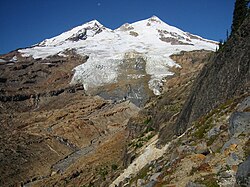
Glaciers are located in ten states, with the vast majority in Alaska. [1] The southernmost named glacier is the Lilliput Glacier in Tulare County, east of the Central Valley of California.
Contents
- Glaciers of Alaska
- Glaciers of the Pacific Coast Ranges
- Washington
- Oregon
- California
- Glaciers of Nevada (in the Basin and Range Province)
- Glaciers of the Rocky Mountains
- Colorado
- Idaho
- Montana
- Utah
- Wyoming
- See also
- Notes
- References
Apart from Alaska, around 1330 glaciers, 1175 perennial snow fields, and 35 buried-ice features have been identified. [2] [3]












